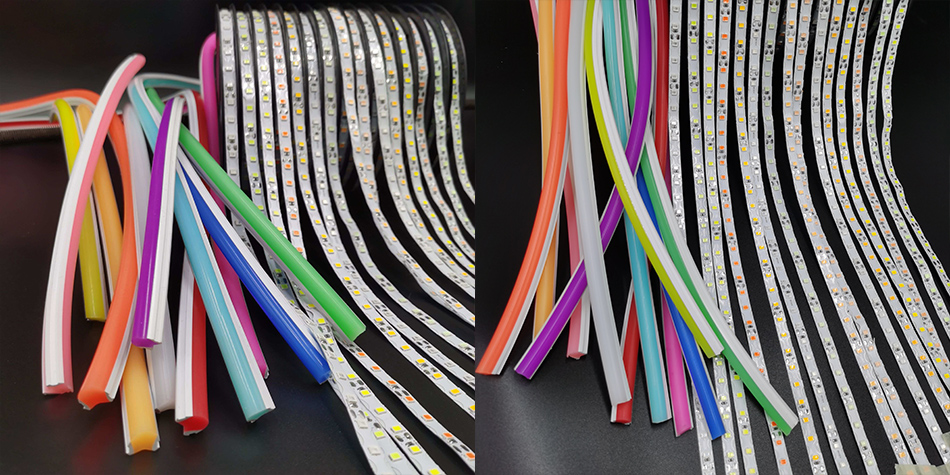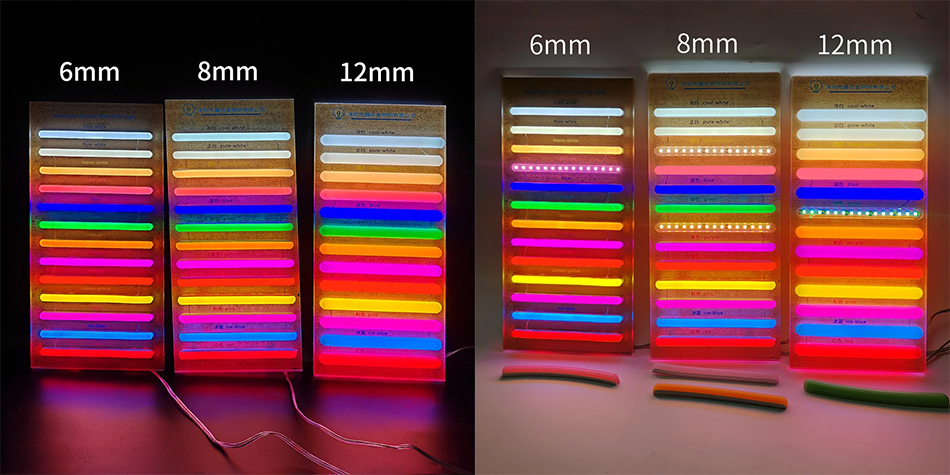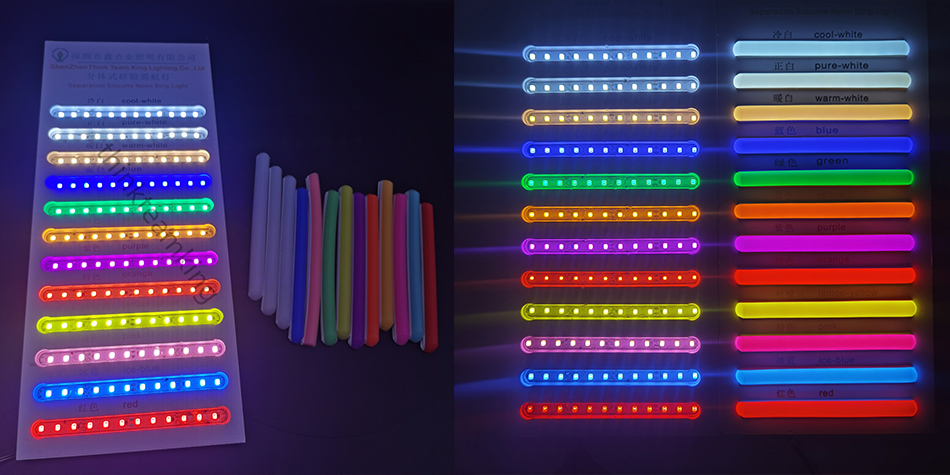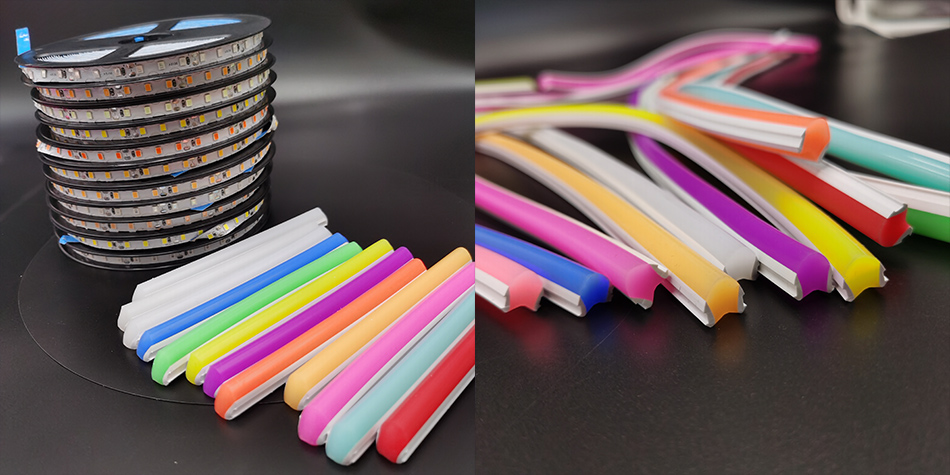Time:2025-06-30
In the ever - evolving landscape of lighting solutions, neon strip lights have emerged as a popular and versatile option. Blending the charm of traditional neon lighting with modern technological advancements, these lights have found their way into a plethora of applications across various industries. This article will take an in - depth look at neon strip lights, exploring their construction, features, applications, installation, maintenance, and future trends.
Construction and Technology of Neon Strip Lights
The Basics of Neon Strip Light Structure
At the core of a neon strip light is a flexible strip, typically made of a durable plastic or silicone material. This flexible base serves as the foundation for the entire lighting system. Embedded within this strip are numerous small LED (Light - Emitting Diode) bulbs. These LEDs are the source of light in neon strip lights. When an electrical current is passed through them, they emit light, creating a continuous and often vibrant glow along the length of the strip.
The spacing between the LEDs is carefully designed to ensure a uniform distribution of light. In some high - end neon strip lights, the LEDs are spaced closely together, resulting in a more seamless and intense illumination. The flexible strip also allows for easy installation in a variety of settings, whether it's on a flat surface, around corners, or along curved edges.
LED Technology in Neon Strip Lights
The LEDs used in neon strip lights are a key technological aspect. These LEDs are highly energy - efficient compared to traditional lighting sources. They consume significantly less power while still producing a bright and clear light. This energy efficiency not only helps in reducing electricity bills but also makes neon strip lights an environmentally friendly choice.
Moreover, LEDs offer a wide range of color options. Through the use of different semiconductor materials and coatings, LEDs can emit light in virtually any color of the visible spectrum. Some neon strip lights even come with RGB (Red, Green, Blue) or RGBW (Red, Green, Blue, White) technology, allowing users to change the color of the light according to their preferences or the requirements of the space. This color - changing ability adds an extra layer of versatility to neon strip lights.
Encapsulation and Protection Features
To ensure durability and functionality in different environments, neon strip lights are often encapsulated. In many cases, a clear or colored silicone coating is applied over the strip containing the LEDs. This silicone coating provides several benefits. Firstly, it protects the LEDs from dust, dirt, and moisture, making the neon strip lights suitable for both indoor and outdoor use.
For outdoor applications, some neon strip lights are designed to be waterproof, with ratings such as IP65, IP67, or even IP68. These ratings indicate the level of protection against water and dust ingress. For example, an IP67 - rated neon strip light can withstand temporary submersion in water, making it ideal for use in areas near swimming pools, in gardens during rainy seasons, or in industrial settings where water splashing may occur. The silicone coating also helps in diffusing the light, creating a more even and soft glow, similar to the appearance of traditional neon lights.

Key Features and Benefits of Neon Strip Lights
Exceptional Durability
One of the standout features of neon strip lights is their durability. Unlike traditional glass - based neon lights that are fragile and prone to breakage, neon strip lights are much more robust. The flexible plastic or silicone construction can withstand bumps, vibrations, and minor impacts without getting damaged. This makes them suitable for use in high - traffic areas, such as commercial spaces with a lot of footfall or in industrial environments where there may be mechanical movements.
The LEDs used in neon strip lights also have a long lifespan. With proper care and under normal operating conditions, they can last for tens of thousands of hours. This long lifespan reduces the need for frequent replacements, resulting in cost savings over time. Whether it's for a long - term installation in a retail store or for a permanent lighting solution in a home, the durability of neon strip lights ensures reliable performance.
Energy Efficiency
As mentioned earlier, neon strip lights are highly energy - efficient. The LED technology they employ consumes far less power than traditional incandescent or fluorescent lighting. This energy efficiency is not only beneficial for the end - user in terms of reduced electricity costs but also has a positive impact on the environment.
By using less energy, neon strip lights contribute to lower carbon emissions and help in conserving energy resources. In an era where sustainability is a growing concern, the energy - efficient nature of neon strip lights makes them an attractive option for both residential and commercial consumers. For businesses, especially those with large - scale lighting requirements, the energy savings from using neon strip lights can be substantial over the long run.
Aesthetic Versatility
Neon strip lights offer a wide range of aesthetic possibilities. Their ability to emit light in different colors, including vibrant and bold hues, makes them perfect for creating eye - catching visual effects. In interior design, they can be used to add a pop of color to a room, highlighting architectural features, furniture, or decorative elements.
For example, placing neon strip lights under kitchen cabinets can provide a soft, ambient light while also adding a modern and stylish touch. In a living room, they can be installed along the edges of a bookshelf or around a TV stand to create a unique and inviting atmosphere. In commercial spaces, such as retail stores, neon strip lights can be used to draw attention to products on display, enhancing the overall visual merchandising. Their flexibility also allows for creative installation designs, such as forming custom shapes or patterns, further expanding their aesthetic appeal.
Customizability
Another significant advantage of neon strip lights is their customizability. They can be cut to the desired length, allowing for easy installation in any space, regardless of its size or shape. This makes them suitable for both small - scale projects, like adding a touch of lighting to a small nook in a home, and large - scale installations, such as illuminating the entire perimeter of a commercial building.
Some neon strip lights also come with dimming capabilities, enabling users to adjust the brightness of the light according to the mood or the specific requirements of the activity in the space. Additionally, with the advent of smart lighting technology, many neon strip lights can be integrated with smart home systems. This allows for remote control of the lights, including turning them on or off, changing the color, and adjusting the brightness, all from a smartphone or other smart devices.

Applications of Neon Strip Lights
Interior Decor in Residential Spaces
In homes, neon strip lights have become a popular choice for enhancing interior decor. They can be used in various rooms to create different effects. In bedrooms, for instance, a soft - colored neon strip light installed under the bed can create a cozy and relaxing atmosphere. It can also serve as a night - light, providing just enough illumination without being too harsh.
In living rooms, neon strip lights can be used to highlight the edges of a floating shelf, around a fireplace, or along the ceiling cove. This not only adds a decorative element but also makes the space feel more spacious and inviting. In kitchens, they are commonly used under cabinets to provide task lighting while cooking or cleaning. They can also be installed inside kitchen cabinets to showcase dishes or glassware. Even in bathrooms, neon strip lights can be used to add a touch of luxury, such as by illuminating the edges of a vanity mirror or along the bathtub.
Retail and Commercial Spaces
Retail stores rely heavily on effective lighting to attract customers and showcase products. Neon strip lights play a crucial role in this regard. They can be used in window displays to create eye - catching visual effects that draw the attention of passers - by. Inside the store, neon strip lights can be installed along the aisles to guide customers, around product shelves to highlight merchandise, or in dressing rooms to provide flattering lighting for customers trying on clothes.
In restaurants and cafes, neon strip lights can be used to create a unique dining atmosphere. They can be installed under tables, along the bar, or around the perimeter of the dining area. Different colors can be used to match the theme or mood of the establishment. For example, warm - colored neon strip lights can create a cozy and intimate setting, while bright and colorful lights can give a more energetic and lively feel.
Outdoor Lighting
Outdoor spaces also benefit greatly from the use of neon strip lights. In gardens, they can be used to line pathways, creating a safe and visually appealing way for people to navigate at night. They can also be wrapped around trees or installed along the edges of flower beds to add a touch of magic to the outdoor landscape.
For outdoor entertainment areas, such as patios and decks, neon strip lights can be used to create a party - like atmosphere. They can be installed under the railing, around the edges of the seating area, or in the pergola. In addition, neon strip lights can be used to highlight the architectural features of a building's exterior, such as eaves, columns, or balconies, making the building more visually appealing at night.
Automotive and Marine Applications
In the automotive industry, neon strip lights are used for both aesthetic and functional purposes. Inside the vehicle, they can be installed under the dashboard, in footwells, or in the trunk to provide additional lighting. This not only makes it easier to find items in the dark but also adds a custom and stylish look to the vehicle's interior.
For marine applications, neon strip lights are a popular choice for boats. They can be used for deck lighting, navigation lighting, and interior lighting. The waterproof and durable nature of neon strip lights makes them suitable for the harsh marine environment, where they may be exposed to water, salt spray, and humidity.

Installation Considerations for Neon Strip Lights
Surface Preparation
Before installing neon strip lights, proper surface preparation is essential. The surface where the strip will be attached should be clean, dry, and free of any dirt, grease, or debris. In some cases, it may be necessary to use a mild detergent and water to clean the surface thoroughly. After cleaning, the surface should be allowed to dry completely.
For rough or uneven surfaces, additional steps may be required. Sanding the surface slightly can help to create a smoother base for the neon strip light to adhere to. In some situations, applying a primer may also be beneficial, especially if the surface is porous or if the neon strip light needs to be firmly attached for a long - term installation.
Electrical Connection
Connecting neon strip lights to the power source requires careful attention to safety and proper installation procedures. First, it's important to determine the appropriate power supply for the neon strip light. This depends on factors such as the length of the strip, the number of LEDs, and the voltage requirements of the strip.
All electrical connections should be made using appropriate connectors and wiring. In outdoor or wet environments, waterproof connectors should be used to prevent water from entering the electrical system and causing short - circuits. It's also crucial to ensure that the wiring is routed in a way that protects it from damage, such as being pinched or abraded. If in doubt about the electrical connection process, it's advisable to consult a professional electrician.
Mounting the Neon Strip Light
There are several methods for mounting neon strip lights. Some strips come with an adhesive backing, which allows for easy installation on smooth surfaces. However, for more permanent or heavy - duty installations, mechanical fasteners such as screws, clips, or brackets may be required.
When using mechanical fasteners, care should be taken not to damage the neon strip light or the flexible strip housing the LEDs. The strip should be installed in a way that allows for proper heat dissipation, as LEDs generate heat during operation. Additionally, the mounting method should not compromise the flexibility or the overall functionality of the neon strip light.

Maintenance and Troubleshooting of Neon Strip Lights
Regular Inspection
Regular inspection of neon strip lights is important to ensure their optimal performance. Periodically, visually inspect the strip for any signs of damage, such as cracks in the flexible strip, loose connections, or a decrease in light output. In outdoor installations or in environments where the strip may be exposed to harsh conditions, more frequent inspections may be necessary.
Check the electrical connections for any signs of corrosion, especially in wet or humid environments. If any issues are detected during the inspection, they should be addressed promptly to prevent further damage and to ensure the continued reliability of the lighting system.
Cleaning
Cleaning neon strip lights is relatively straightforward. A soft, damp cloth can be used to wipe away dust, dirt, or any residues on the surface of the strip. In cases where the strip is exposed to more stubborn contaminants, such as grease or oil, a mild, non - abrasive cleaner can be used.
However, it's important to avoid using harsh chemicals or abrasive materials that could damage the flexible strip or the LEDs. After cleaning, the strip should be allowed to dry completely before turning the power back on to prevent any potential electrical problems.
Troubleshooting Common Issues
If a neon strip light experiences problems, such as flickering, dimming, or failure to turn on, there are several common issues to check. First, verify the electrical connection to ensure that the power supply is functioning correctly and that all connections are secure. A loose connection or a faulty power supply can often cause these problems.
If the electrical connection is fine, check for any physical damage to the strip. A damaged LED, a break in the flexible strip, or a malfunctioning controller (if the strip has color - changing or dimming capabilities) can also lead to issues. In some cases, if only a section of the strip is not working, it may be possible to isolate and repair the problem. However, if the entire strip is malfunctioning, it may need to be replaced. Refer to the manufacturer's troubleshooting guide for specific instructions on resolving these issues.

Trends and Future Developments in Neon Strip Lights
Smart Lighting Integration
The future of neon strip lights is likely to see increased integration with smart lighting technology. Smart lighting systems allow for greater control and customization of the lights. With the use of smartphone apps or voice - controlled devices, users will be able to change the color, brightness, and even the lighting pattern of neon strip lights with ease.
This integration will also enable features such as scheduling, where the lights can be programmed to turn on and off at specific times. In addition, smart sensors can be integrated with neon strip lights, allowing them to respond to environmental conditions, such as motion or ambient light levels. For example, the lights can automatically turn on when someone enters a room or adjust their brightness based on the amount of natural light available.
Advancements in LED Technology
As LED technology continues to evolve, neon strip lights will benefit from these advancements. Future LEDs may offer even higher brightness levels, better color rendering, and increased energy efficiency. This will result in neon strip lights that are even more vibrant, true - to - color, and cost - effective to operate.
There may also be developments in the size and shape of LEDs, allowing for even more flexible and creative installation options. For example, smaller and more compact LEDs may be used, enabling neon strip lights to be installed in even tighter spaces or to create more intricate lighting designs.
Sustainable and Eco - Friendly Innovations
With the growing focus on sustainability, the neon strip light industry is likely to see more eco - friendly innovations. This may include the use of recycled materials in the construction of the flexible strip and the packaging of the product. Additionally, efforts may be made to reduce the overall environmental impact of the manufacturing process.
Manufacturers may also focus on developing neon strip lights with longer lifespans, reducing the need for frequent replacements and minimizing waste. In addition, more energy - efficient manufacturing techniques may be adopted to further reduce the carbon footprint associated with the production of neon strip lights.
In conclusion, neon strip lights have come a long way from their traditional neon counterparts. With their combination of style, functionality, and technological advancements, they have become a popular lighting choice in a wide range of applications. As technology continues to progress and trends in smart lighting, LED innovation, and sustainability emerge, neon strip lights are set to become even more advanced and widely used, illuminating our world in new and exciting ways.